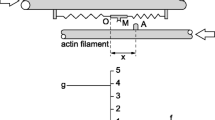Abstract
A muscle model based on the sliding filament concept is put forward. The model is simplified in such a way that it may easily be simulated on a computer (analog or digital). The model shows quite a few muscle properties rather well e.g. Hill's relation, quick-stretch and quick-release series elasticity and some dynamic transfer properties. It is found that, using an antagonistic muscle model pair and an appropriate load, realistic arm movements can be simulated.
Similar content being viewed by others
References
Bahler,A.S.: Modelling of mammalian skeletal muscle. Bio Med. Eng. 15, 249–257 (1968).
Blangé,T., Karemaker,J.M., Kramer,A.E.J.L.: Elasticity of skeletal muscle in relation to the “sliding filaments” model. Biomechanics II. Basel: S. Karger 1971.
Buchthal,F., Schmalbruch,H.: Contraction times and fibre types in intact human muscle. Acta Physiol. Scand. 79, 435–452 (1970).
Caplan,S.R.: A characteristic of self regulated linear energy converters: the Hill force-velocity relationship for muscle. J. theor. Biol. 11, 63–86 (1966).
Davies,R.E.: A molecular theory of muscle contraction. Nature (London) 199, 1068–1094 (1963).
Ebashi,S., Endo,M., Otsuko,I.: Control of muscle contraction. Quart. Rev. Biophys. 2, 351–384 (1969).
Hill,A.V.: The heat and shortening and the dynamic constants of muscle. Proc. Roy. Soc. B 126, 136–195 (1938).
Hill,A.V.: First and last experiments in muscle mechanics. Cambridge: Univ. Press 1970.
Hill,T.L.: Phase transition in the sliding filament model of muscular contraction. Proc. N.A.S. 59, 1194–1200 (1968).
Hill,T.L.: Sliding filament models of muscular contraction V. J. theor. Biol. 29, 395–410 (1970).
Huxley,A.F.: Muscle structure and theories of contraction. Progr. Biophys. biophys. Chem. 7, 279–305 (1957).
Huxley,H.E.: The mechanism of muscular contraction. Science 164, 1356–1366 (1969).
Jewell,B.R., Wilkie,D.R.: The mechanical properties of relaxing muscle. J. Physiol. (Lond.) 152, 30–47 (1960).
Julian,F.J.: Activation in a skeletal muscle contraction model with a modification for insect fibrillar muscle. Biophys. J. 9, 547–570 (1969).
Partridge,L.D.: Signal-handling characteristics of load-moving skeletal muscle. Amer. J. Phys. 210, 1178–1191 (1966).
Partridge,L.D.: Intrinsic feedback factors producing inertial compensation in muscle. Biophys. J. 7, 853–861 (1967).
Sandow,A.: Skeletal muscle. Ann. Rev. Physiol. 32, 87–138 (1970).
Taylor,C.P.S.: Isometric muscle contraction and the active state, an analog computer study. Biophys. J. 9, 759–780 (1969).
Wilkie,D.R.: Mechanical properties of muscle. Brit. med. Bull. 12, 177–182 (1956).
Author information
Authors and Affiliations
Rights and permissions
About this article
Cite this article
Dijkstra, S., Denier van der Gon, J.J., Blangé, T. et al. A simplified sliding-filament muscle model for simulation purposes. Kybernetik 12, 94–101 (1973). https://doi.org/10.1007/BF00272465
Received:
Issue Date:
DOI: https://doi.org/10.1007/BF00272465




